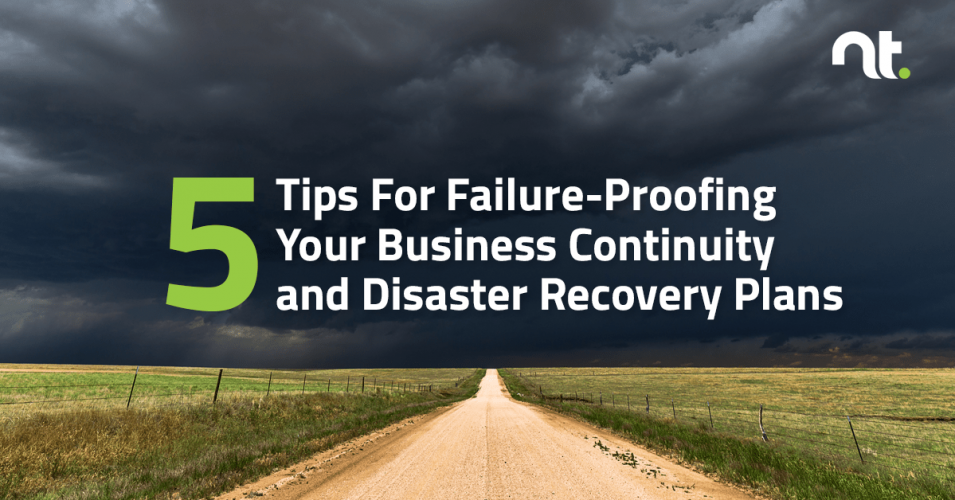READ TIME: 4 MIN

5 Tips for Failure-Proofing Your Business Continuity and Disaster Recovery Plans
In a day and age where IT downtime costs $20,000 an hour, SMBs can’t afford to leave disaster recovery planning to chance.
Recently, we talked about various threats SMBs face — from natural disasters and cyberthreats to day-to-day hardware failures. We also showed how most disasters strike when we least expect them, and for the unprepared business, downtime costs can range from $20,000 per hour to total business loss.
If you’re reading this, there’s a good chance you don’t want to be like the more than 75 percent of small businesses that have no disaster plan in place. And you don’t want to be like the 71 percent of companies that don’t back up data from SaaS environments like Salesforce or Microsoft Office 365.
Here are some best practices you should follow as you develop your business continuity and disaster recovery (BCDR) strategy:
#1: Avoid Cost-Per-Gigabyte Backup Plans
In the past, backing up data to an offsite private data center or the cloud was primarily sold by the gigabyte with price reductions given once specific thresholds were met (e.g., a 10 percent cost-per-gigabyte [CPG] reduction after reaching 100 GB level). These data plans make it difficult to predict your monthly expenses because it’s impossible to predict how much your data needs are going to grow. Once you’re locked into one of these programs, it can be challenging to migrate to another plan. Plus, CPG plans often lead to compromises such as backing up only what’s deemed “mission-critical data” to reduce costs. Avoid this complexity and choose a modern, fixed-rate plan with a more predictable cost structure.
#2: Don’t Use Consumer-Grade Backup Software
There are lots of choices when it comes to selecting backup software, and several pitfalls you’ll need to avoid. One of the primary pitfalls we see is SMBs using consumer-grade backup software, such as the free offerings that come with Windows and Apple computers. These apps offer limited features and functionality. For example, they’re not managed, so that even if the backups work correctly early on, events such as software updates and system patches can cause backups to stop working without warning.
With a managed BCDR solution, on the other hand, users’ computers and servers can be viewed from a web-based portal. If a backup fails, an automated alert lets you know right away, and in many cases, the problem can be fixed remotely.
#3: Identify Your RTO and RCO Needs
Another critical BCDR selection consideration is how quickly it can recover data. To determine how fast you need it to recover your data, start with the following key metrics:
- Recovery Time Objective (RTO): RTO is how much time an application can be down without significantly harming your business. For example, a small plumbing company could get by with paperwork orders and invoicing for a week or more. An online retailer that does a high order volume, on the other hand, might only be able to withstand an hour of downtime. More than the time duration between data loss and recovery, RTO also defines what IT must do to restore the application and its data.
- Recovery Point Objective (RPO): How much time is acceptable to lose data before significantly damaging the business? A shorter RPO is vital for customer-facing applications. The RPO number decides how frequently data backup sets should be performed.
#4: Don’t Wait For Disasters To Validate Your Data Recovery Strategy
Even if you’re using a managed BCDR solution that confirms each successful backup, there’s one more step you should take to avoid getting burned by a “false positive.” Validate your recovery plan regularly. With legacy backup and recovery apps, this step was cost-prohibitive and time-consuming for testing large (e.g., 1 TB or more) data sets. However, some of today’s BCDR solutions support virtualization, which enables you to perform a virtual machine (VM) restore in a fraction of the time it takes to complete a physical image recovery. Additionally, you can perform the recovery in an environment that’s dissimilar to the production environment, which eliminates the necessity of building duplicate servers and drivers before beginning the restore process. What’s also attractive about performing a VM restore is that it can be performed without disrupting your production environment and with minimal effort.
#5: Work with a Professional DRaaS Provider
If any of the points outlined earlier felt a bit overwhelming to implement, remember this: you don’t need to figure this out on your own. And, it’s probably not a good idea to try. Working with a disaster recovery as a service (DRaaS) provider like NexusTek is more likely the more economical and less risky option.
NexusTek Cloud Services offer the flexibility, visibility, and control businesses need to be agile and can address your company’s unique cybersecurity, business continuity, compliance and auditing requirements in cloud, hybrid or on-premise environments.
With our disaster recovery and backup services, your business never misses a beat. Leveraging award-winning tools like Veeam Backup for Microsoft Office 365, we can help eliminate the risk of losing access and control over your Office 365 data including Exchange Online, SharePoint Online and OneDrive for Business, ensuring your data is always available and protected.
With our DRaaS offering, your data is backed up continuously and immediately retrievable in the event of a disaster.
Eventually, you’re going to face a situation that requires data to be restored from a backup, whether it’s a single file that was deleted by accident or an entire network of files encrypted by a ransomware virus. Whether the recovery is a success or a flop will depend on the quality of your BCDR technology, and the competence of those responsible for using it. When you partner with a DRaaS provider like NexusTek, you can rest assured that we have you covered on both fronts.






